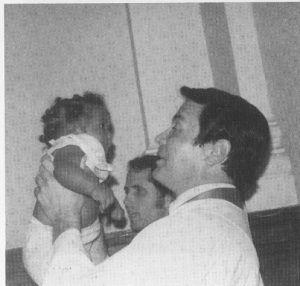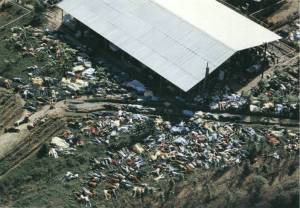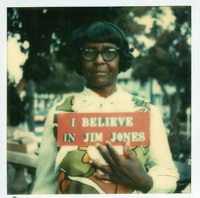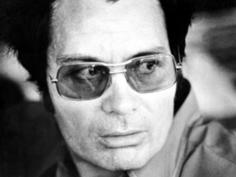 About a generation ago, a charismatic preacher and self-proclaimed Jesus called James Warren Jones took about a thousand of his followers to Guyana, to hack out of the jungle a righteous community called (naturally) Jonestown. It was to be an egalitarian Heaven on Earth, a place where the colony’s children could grow up safe and free, without racial prejudice or government persecution, and the old people could live out their lives in peace and the best of care. What happened then added at least two expressions to the language: “Jonestown,” as shorthand for a suicide cult; and the phrasal verb “to drink the kool-aid.”
About a generation ago, a charismatic preacher and self-proclaimed Jesus called James Warren Jones took about a thousand of his followers to Guyana, to hack out of the jungle a righteous community called (naturally) Jonestown. It was to be an egalitarian Heaven on Earth, a place where the colony’s children could grow up safe and free, without racial prejudice or government persecution, and the old people could live out their lives in peace and the best of care. What happened then added at least two expressions to the language: “Jonestown,” as shorthand for a suicide cult; and the phrasal verb “to drink the kool-aid.”
This messiah, commonly known as the Reverend Jim Jones, was born in 1931 in tiny Crete, Indiana, only child of working-class parents. As a kid, he made an early start on messiahship by preaching sermons on his porch to other kids. As a young man, he set up as a faith healer, removing cancers with an odd resemblance to chicken livers; he preached serially for the Methodists and Pentecostals, but fell out with both. In 1955 he founded his own church in Indianapolis, mixed-race in an era when this was unusual, with services in a style more common in black churches, and a theology mixing old-time Pentecostalism with socialism and civil rights: the Peoples Temple.
In 1957, he was mentored by the superstar evangelist Father Divine, full name Father Major Jealous Divine, born 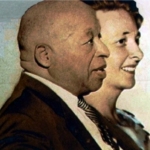 George Baker, aka God, messiah of the Peace Mission religious movement since 1932. Relations with Father Divine were warm at first, but—according to Father Divine’s wife, Mother Divine, a Vancouver girl some 40 years younger than her husband, and still around—they fell out when Jones announced that he was in fact God, and the natural heir to the lucrative Peace Mission empire. This began a long-standing feud between Jones and Mother Divine, the designated successor, who spent the next twenty years fending off Jones’s takeover bids. After Father Divine’s tutelage, however, Jones’s own ministry changed—notably, miraculous healings became a greater feature of his services, using shills planted among the believers for the purpose of being miraculously healed. His church flourished. New members—and money—rolled in.
George Baker, aka God, messiah of the Peace Mission religious movement since 1932. Relations with Father Divine were warm at first, but—according to Father Divine’s wife, Mother Divine, a Vancouver girl some 40 years younger than her husband, and still around—they fell out when Jones announced that he was in fact God, and the natural heir to the lucrative Peace Mission empire. This began a long-standing feud between Jones and Mother Divine, the designated successor, who spent the next twenty years fending off Jones’s takeover bids. After Father Divine’s tutelage, however, Jones’s own ministry changed—notably, miraculous healings became a greater feature of his services, using shills planted among the believers for the purpose of being miraculously healed. His church flourished. New members—and money—rolled in.
Many good works were done in this period. In particular, Jones was strong on racial equality. He and his wife Marceline were the first whites in Indiana to adopt a black child, and eventually acquired a “rainbow” family of children of different ethnic origins. In 1960, he was made director of the Indianapolis human rights commission. In 1961, though he had no theological training, he was ordained by the Pentecostal Disciples of Christ.
Nevertheless, cracks were already showing in the Temple façade. Jones was the true emperor of his little empire; disenchanted members were harassed if they attempted to leave; dark rumours of corruption and abuse began to circulate. When things began to get slightly too hot for him in Indianapolis in the early 1960s, Jones claimed a vision of a coming nuclear apocalypse that would leave the Midwest, including Indianapolis, in smoking ruins; he, however, would lead his worshipful congregation to safety, to await the rise of a socialist paradise from the ashes of the war. In this case, “safety” meant a church commune in Ukiah, Northern California, which Jones had heard would be one of the nine safest places in the world during a nuclear holocaust.
Jones was a hit in California. Over the next ten years, his following grew to over 3000 members, and opened branches in LA and San Francisco. The Peoples Temple became known for good works among the poor black communities, and got much good publicity; and Jones got to rub shoulders with such luminaries as Angela Davis, Jane Fonda, Rosalyn Carter, and Mayor George Moscone. In 1976, he was co-opted to the San Francisco Housing Authority. Friendly politicians knew Jones could lend them instant crowds by the busload, for rallies or protest marches. The kid preaching to his schoolmates in small-town Indiana had come a very long way.
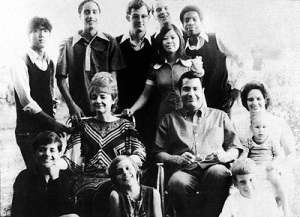
But what was happening inside the Peoples Temple? Jones was the absolute dictator of everything from beliefs to behaviour—even to thoughts, so far as he could control them, which was surprisingly far. The memoirs of defectors give a sense of a kind of slavery, willingly undertaken in the first place, and astoundingly hard to break free of. The commitment he demanded from his followers was total – they were to cut themselves off from all relationships outside the church, most especially family, except those whom Jones was trying to lure into membership.
Then there were time commitments: all spare time, up to the early hours of the morning. The temple was to be the centre of the members’ world. As well, there were heavy financial commitments. Devotees were to liquidate and donate all assets to Jones, along with all earnings from outside jobs, savings, welfare cheques, and money borrowed from unconverted family members. They were encouraged to sell their houses and move into the church commune, where Jones could easily control them, either directly, or through spies who would report even the slightest hint of deviation. This ensured members would not form bonds that might compete with their 100% allegiance to the good pastor. Any deviations, including even hints of selfishness, sexism or racism, or even lack of cheeriness or courtesy, could be severely punished. Living conditions were spartan, and possessions at a minimum, lest material desires distract the faithful from Jones and from socialist principles. At the same time, Jones lived in great comfort, and was addicted to a variety of drugs by 1974 at the latest. This did not help his rationality quotient any.
Sexual commitments were also demanded. Jones was bisexual, though he styled himself the only real heterosexual on the planet. But by the peculiar logic he sold to his followers, they were supposed to be celibate with each other, even their own spouses, but be ready to have sex with him, a privilege he exercised with both male and female devotees. The lower ranks, though, were encouraged to produce lots of babies.
 The penalties for any deviation—even suspected thoughtcrime—were brilliantly effective. Scapegoating and shunning were common, but the main technique was called “catharsis.” This involved public confession and humiliation, often including having to strip naked in front of the congregation, followed by beatings, spankings, or boxing matches with stronger opponents. Those must have been some church services.
The penalties for any deviation—even suspected thoughtcrime—were brilliantly effective. Scapegoating and shunning were common, but the main technique was called “catharsis.” This involved public confession and humiliation, often including having to strip naked in front of the congregation, followed by beatings, spankings, or boxing matches with stronger opponents. Those must have been some church services.
The belief system that tied these people to their messiah, which has been called “apostolic socialism,” was no orthodox form of Christianity. A Marxist and keen admirer of Stalin, Jones melded Marxist-Leninist rhetoric with his own bizarre religious ideas, mainly involving himself. He was God, but he was also a reincarnation of Jesus, the pharaoh Akhenaten, Buddha, Allah, Lenin, and Father Divine. His followers were to call him Father—or Dad. In his own words:
“I am causing untold thousands to believe in the Jesus of ancient history by the great miracles of healings, prophecies and discernments I perform in His name!”
This was in almost the same breath as he stomped on the Bible, and declared, “I come as God Socialist!” And since most of his followers began as devout black evangelical Christians, how did he get away with it?
First and foremost, he had charisma. He was bright, narcissistic, and very likely a clinical psychopath, with all the plausibility and chameleon charm of the type. He also cheated, performing carefully orchestrated healings and miracles—like changing water into wine—to attract and hold new members. Many thought they were joining a fundamentalist Christian church, and stayed because of Jones’s seductive personality. He was the glue that held it all together.
Second, he frightened them. In the Temple’s sealed-off world, Jones convinced his followers that powerful capitalist forces were out to destroy or enslave them, that the US government was building concentration camps for black people, and that their only hope lay in him. The galloping paranoia he induced in them has a lot to do with the fate of Jonestown.
Other manipulations helped. While salting away large sums in Swiss bank accounts, Jones projected himself as the only true friend of the poor, especially among the black community. The temple’s outreach was charitable on the surface; many poor people were helped financially, and made to feel valued. Members who had no cash to donate could donate labour instead, effectively becoming a pool of willing slaves.
His followers fell into two groups, with interesting differences. Although the Peoples Temple was theoretically egalitarian, it was structured as a standard social pyramid. Jones was, of course, in sole occupancy of the top of the heap. Close to him was a high command of about a dozen “angels,” perched atop 100-150 members of the upper echelons, the “planning committees”. These were mostly white, middle-class, and educated. Below them were the hoi polloi: up to 3000 “ordinary” members, mostly black, working class and uneducated. The harsh discipline and “catharsis” sessions were largely aimed at the angels and upper echelons, reminiscent of Orwell’s novel 1984, where party members were terrorized and scrutinized, but the proles were pretty much left alone.
The appeal was different for these two strata. The lower level was drawn from the desperately poor. For them, Jones played the Good Shepherd, offering community, food, and certainty about the world. All he asked in return was total devotion and unquestioning belief. His appeal to the educated middle-class whites was different. This was the 1960s—such people drawn to him were fed up with western materialism and Viet Nam, and terrified of nuclear war, and they were therefore easily seduced both by Jones’ apparent commitment to social justice, and his bizarre claims about government conspiracies. Jones gave them a cause, a higher purpose. And in the isolated, underfed, overworked, hothouse atmosphere of the Peoples Temple, cut off from reality checks, the amoral things he ordered his followers to do made perfect sense.
The Reverend’s chief terror was defectors, potential whistle-blowers. Against them, Jones used the faithful to mount campaigns of “dirty tricks,” threats and slander, possibly right up to murder—which still made fine sense to the faithful, because the world was out to get them, and any means of defense was justified.
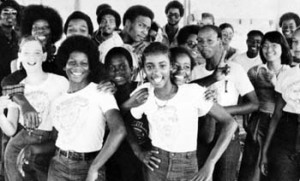 Meantime, Jones was prospecting for a place in wilderness. He found it in an isolated corner of Guyana, and thus Jonestown was born. It was to be a socialist utopia, with him at its centre, safe from the capitalist warmongering US government. Some trusted lieutenants went out to start building the infrastructure, and Jones gradually began moving out a few of the faithful. To reassure those remaining in California, he distributed brochures of happy, smiling residents accomplishing wonders of construction and cultivation in the wilderness.
Meantime, Jones was prospecting for a place in wilderness. He found it in an isolated corner of Guyana, and thus Jonestown was born. It was to be a socialist utopia, with him at its centre, safe from the capitalist warmongering US government. Some trusted lieutenants went out to start building the infrastructure, and Jones gradually began moving out a few of the faithful. To reassure those remaining in California, he distributed brochures of happy, smiling residents accomplishing wonders of construction and cultivation in the wilderness.
In fact, these were fairly close to the truth. According to residents fortunate enough to be away from Jonestown on the critical date in 1978, Jonestown was a happy place, just so long as Jones was not there. Living conditions were basic and the work was hard, but they were building something they believed in, and the atmosphere was relaxed and optimistic.
But back in California, things were beginning to go sour as Jones’s paranoia and addictions spiraled out of control. Worse, dangerously well-informed defectors began talking to the media: the public beatings, the Swiss bank accounts, tax evasion, conspiracies to murder and harass, sex, drugs, and mind control. A devastating exposé was set to come out; the feds were interested in the possibility of tax evasion and alleged human rights abuses. Clearly, Jones was about to be issued a huge reality check. In a panic, he began a mass exodus of his followers to Jonestown in the summer of 1977, days before the exposé was published.
In the following months, Heart of Darkness met 1984 in the Guyanese jungle. Jonestown became a virtual concentration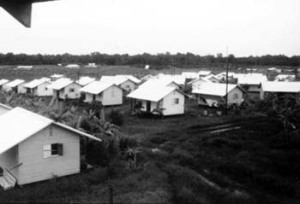 camp. Jones was in a bad way when he arrived, addled by drugs and enraged at the dark forces of the CIA. And with Dad in residence, life at Jonestown became very hard. All the vicious mind-control and punitive techniques were intensified. New arrivals had all but the most basic necessities taken from them, including prescription drugs, which vanished into Jones’s private stock.
camp. Jones was in a bad way when he arrived, addled by drugs and enraged at the dark forces of the CIA. And with Dad in residence, life at Jonestown became very hard. All the vicious mind-control and punitive techniques were intensified. New arrivals had all but the most basic necessities taken from them, including prescription drugs, which vanished into Jones’s private stock.
Isolation was complete. The faithful were trapped in the middle of a wilderness, without passports or practical access to transport. Communication was filtered through Jones and his fanatical inner circle—a ham radio was used to pass coded messages to his outer empire. For example, “Send more bibles” was code for “send more guns”. Letters to the outside were censored, and woe betide any who failed to express revolutionary joy at living in this workers’ Eden.
Each day held hard labour from sunup to sundown, followed by a sparse evening meal of beans and rice, and then by endless meetings presided over by Jones, or mandatory classes in Marxist theory and the Russian language, in case Jones decided to relocate the colony to the Soviet Union. After residents were allowed to stumble to bed, Jones harangued them all through the night, on tape over loudspeakers, rambling monologues on socialism, his own divinity, and the dangers surrounding the colony.
Most significant were the escalating terror tactics. Armed guards were everywhere. No one dared complain about worsening conditions; punishments became more violent. Worst of all were the “white nights,” when guards herded everyone out of bed to the pavilion, where an agitated Jim Jones would announce Jonestown was under attack, and “revolutionary suicide” was the only way out. A vat of Flavor-Aid would be brought in; Jones would say it was laced with cyanide, and order his faithful to line up and drink, and they did. But these were only drills.
Disturbing reports filtered back to relatives in the States, who became worried that their loved ones were trapped in the wilderness by a tyrant and conman – which was arguably true. Congressman Leo Ryan flew down to Guyana to investigate, landing at the nearest airstrip, Port Kaituma, on Friday Nov. 17th, 1978, with some journalists. He was not the first US official to visit, and the people of Jonestown were well-rehearsed. Guests were shown a carefully arranged and prettied version of Jonestown.
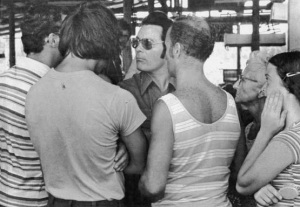 The congressman, won over, made a speech about how great it all was. Everybody cheered. But next morning, a few people slipped notes to Ryan and the journalists—get us out of here. Confronted with this, Jones said – sure! They could leave if they wanted to. Amid chaotic scenes, about fifteen of the no-longer-so-faithful left Jonestown with Ryan and the journalists, for the airstrip.
The congressman, won over, made a speech about how great it all was. Everybody cheered. But next morning, a few people slipped notes to Ryan and the journalists—get us out of here. Confronted with this, Jones said – sure! They could leave if they wanted to. Amid chaotic scenes, about fifteen of the no-longer-so-faithful left Jonestown with Ryan and the journalists, for the airstrip.
This part of the story is no doubt familiar. Before the planes could take off, a flatbed truck covered with gunmen pulled up on the field and opened fire. A Jones loyalist planted among the refugees began shooting inside one of the planes. Ryan was killed, along with three journalists and one of the would-be escapees. Most of the others were injured.
Back in Jonestown, the Reverend ordered a “white night,” which many at first thought was another drill. The table in the pavilion was covered with syringes and cups of purple liquid. When all but a handful were gathered around him, Jones started to talk. An audiotape exists of what followed, and the few survivors tell consistent tales. Jones played on the siege mentality he had fostered in Jonestown:
Don’t be afraid to die. You’ll see, there’ll be a few people land out here. They’ll torture some of our children here. They’ll torture our people. They’ll torture our seniors. We cannot have this…
“They” in question were not specified: but whoever the enemy, it was better to commit an act of revolutionary suicide, in protest against the racism and fascism of this world:
Lay down your life with dignity. Don’t lay down with tears and agony. There’s nothing to death…it’s just stepping over to another plane. Don’t be this way. Stop this hysterics. This is not the way for people who are Socialists or Communists to die.
Jones did not have it all his own way. A few protested, particularly one Christine Miller, who was shouted down—not by Jones, but by the crowd. Which shows how ready the majority were to continue believing in their messiah, even after the strange hell Jonestown had become. One woman on the tape said:
…it’s been a pleasure walking with all of you in this revolutionary struggle. No other way I would rather go to give my life for socialism, communism, and I thank Dad very, very much.
And so it began. The syringes and cups on the table were for the children, who died first. Evidently they did not like it much. Jones is heard calling for the mothers to stop exciting their children, that they were only crying because the taste was so bitter. A man’s voice is heard on the tape, reacting to the deaths of the children: “…I’d rather see them lay like that than to see them have to die like the Jews did, which was pitiful anyhow. And I just like to thank Dad for giving us life and also death.” And when the children were dead, it was time for the adults.
Some have questioned whether Jonestown was a case of mass suicide, or mass murder. Clearly, it was both. Many people willingly lined up and drank the poisoned potion. Some, including Christine Miller, were forcibly injected with poison, or forced to drink, and a few were shot. (The true ratio will never be known, as very few autopsies could be performed.) The security guards let only five people through the cordon; the rest died. As the line moved up, security guards helped those who had already drunk the concoction to move outside the pavilion, to keep the aisles clear for the rest. Others moved off in family groups, to lie down and die together. But many wanted to die close to their messiah, so in the area around Jones’ chair, the bodies piled up five or six deep, with children in the bottom layer—one of the factors that led to very low early estimates of the death toll. Jones himself died of a bullet in the head, possibly shot at his request by one of the inner circle. There is also evidence that about fifteen of the inner circle remained alive for several hours after Jones was dead, cleaning up and taping news reports off the radio, before drinking the kool-aid themselves.
In all, the death toll at Jonestown was 913, including 276 children. This was the end for Peoples Temple, and for Jonestown. The latter, abandoned, has been gradually returning to the jungle, and is naturally said to be haunted.
Was the tragedy inevitable, given Jones’ personality? No, it was not. It is an odd irony that things could easily have gone the other way—given a little more time, the Peoples Temple could well have routinized. Early Scientology, for example, shows much the same pattern; but as Ron Hubbard aged, he was increasingly sidelined, and his young and efficient inner circle took over. See also Christianity, Islam, and the Latter Day Saints, for starters. In fact, I suspect that many ideologies, if traced back far enough, could be linked to the routinization of a charismatic personality cult. The trick to a cult’s survival, it seems, is to hang on long enough to outlive the messiah, and hope the successor has some solid business sense.
At any rate, this could well have been the path followed by the Peoples Temple if the crisis had not been precipitated on that day in 1978, at a time when the psycho messiah was still in control. As years passed, the inner circle would have taken over as Jones aged and slowly killed himself with drugs; the misery would lessen, conditions would normalize, and the People’s Temple would become just another harmless weirdo sect, rather than a byword for suicidal fanaticism. And in fifty years…perhaps a perfectly respectable religion, with Jones fondly remembered as the revered founder.

